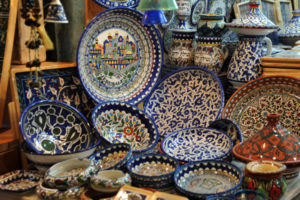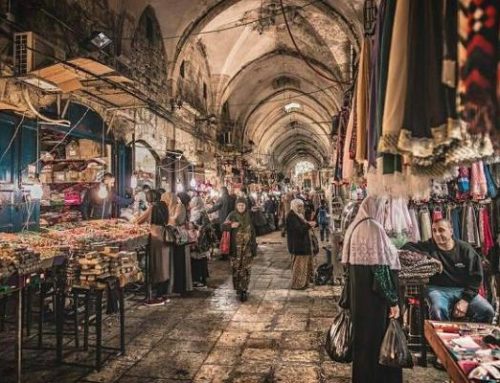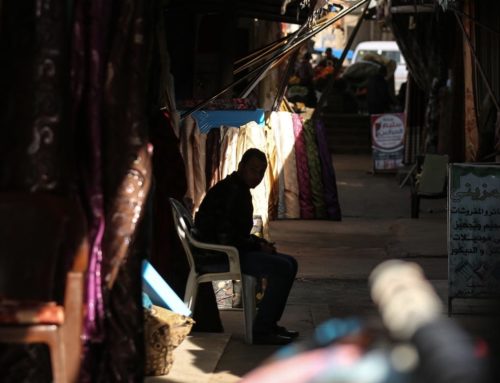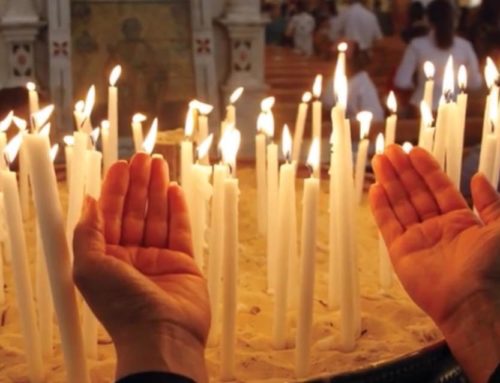After the Israeli occupation of Jerusalem in 1948, and then again in 1967, the production of hand-made goods has been slowed dramatically due to the lack of manpower. Many of the shops that had once existed in Jerusalem either closed, moved to another city or abandoned the entire enterprise because of lack of adequate funding.[1]Nevertheless, some products remained in the city and shaped its economic and cultural sphere. The Armenian ceramic is one of such products.

The Origins:
Although Palestinians had been using ceramics for centuries, [2] ceramic work had been brought to Jerusalem by Armenians at the beginning of the nineteenth century, at the time of the British Mandate.[3]The story started in 1919 when the British High Delegate Mr. Stores brought three Armenian families to Jerusalem to renovate the walls of all of the Al-Aqsa Mosques: the Dome of the Rock and Al-Qibli. The families who migrated originally from the city of Kutahya, an Armenian city famous for its ceramic work, liked the city of Jerusalem and decided to stay..[4]Those families founded a ceramic factory in 1922 and called it “The Dome of the Rock Ceramics”. [5]
Currently there are five families who do ceramic work in Jerusalem. Some of them have shops in the Old City to market their products to tourists and visitors.[6]
Process
The ceramic piece is formed in a specific shape, whether it be a dish, bowl or cup. Then the piece is baked in a special over at a high temperature. Finally, it is painted.[7] A piece needs ten days to be completed.[8]
Jerusalem’s ceramic work and style departed from the traditional Turkish style of geometric forms and plants. Mirroring the Palestinian landscape and environment, the new ceramic work often depicted animals as well.[9] Armenian families kept the traditional Armenian style of flowers that symbolizes eternal life.[10]

Use:
Ceramic pieces have been used for thousands of years, whether it was to create dishes and furniture or to decorate religious centers. Ceramic work has long narrated the stories of nations and different cultures.[11] Similarly, Jerusalem’s ceramic preserves Palestinian identity and traditions.
Currently, ceramic products are being sold in gift shops in the Old City of Jerusalem. Tourists are not the only ones who purchase the ceramics, however. Many local organizations, restaurants and community centers purchase these products to uphold Palestinian culture .[12]

Economically
There are 25 ceramic factories that employ a total of 100 people. Of the products, 30% are marketed locally, 30% are marketed in Occupied Palestine 1948, 20% are exported to the Arab world, while the remaining 20% are exported to the US and Europe.[13]
Challenges
Hand-made ceramic is costly and takes a great deal of time to make. This exposed the Armenian market of ceramics to fierce competition from lower quality and lower priced Turkish and Chinese ceramics. Because of the cheaper products, many of the shops in the Old City prefer the Turkish or Chinese pieces.[14]
The Armenian ceramics also face fierce competition from the Israeli market and from factory-made glass, which costs less to make more.[15]Nevertheless, some tourists would still pay more for a unique hand-made ceramic that symbolizes Jerusalem and narrates its sacred and cultural story.
[1] Nour Arafa, Diagnosis of the local economic resources of East Jerusalem (Jerusalem: Palestine Economic Policy Research Institute, 2017), p 38
[2] This is witnessed in the floors of tens of historic Palestinian houses and palaces in different Palestinian cities such as Jericho, Nazareth, Bethlehem and Jerusalem
[3] “The Ceramic Work: an Armenian Heritage in Jerusalem,” at https://arabic.rt.com/news/600902-صناعة_الخزف.._حرفة_يتوارثها_الأرمن_في_القدس/ posted November 27, 2012
[4] “The Ceramic Factory in Jerusalem: 100 Years of Art and Tradition,” at https://www.alquds.co.uk/%ef%bb%bfمصنع-الخزف-في-القدس-مئة-عام-من-الفنّ-و/ posted February 18, 2017
[5] “Armenian Ceramic: Struggles to Stay in Jerusalem,” at https://www.aljazeera.net/news/alquds/2016/5/23/الخزف-الأرمني-يكافح-للبقاء-في-القدس posted May 24, 2016
[6] https://www.aljazeera.net/news/alquds/2016/5/23/الخزف-الأرمني-يكافح-للبقاء-في-القدس
[7] https://arabic.rt.com/news/600902-صناعة_الخزف.._حرفة_يتوارثها_الأرمن_في_القدس/
[8] https://www.aljazeera.net/news/alquds/2016/5/23/الخزف-الأرمني-يكافح-للبقاء-في-القدس
[9] https://www.alquds.co.uk/%ef%bb%bfمصنع-الخزف-في-القدس-مئة-عام-من-الفنّ-و/
[10] https://www.aljazeera.net/news/alquds/2016/5/23/الخزف-الأرمني-يكافح-للبقاء-في-القدس
[11] https://arabic.rt.com/news/600902-صناعة_الخزف.._حرفة_يتوارثها_الأرمن_في_القدس/
[12] https://www.alquds.co.uk/%ef%bb%bfمصنع-الخزف-في-القدس-مئة-عام-من-الفنّ-و/
[13] Id
[14] https://www.aljazeera.net/news/alquds/2016/5/23/الخزف-الأرمني-يكافح-للبقاء-في-القدس
[15] “The Palestinian Ceramic: a Story of Palestinian Resistance,” at http://www.al-ayyam.ps/ar_page.php?id=670cbb1y108055473Y670cbb1 posted June 7, 2009
Pictures:
- https://en.wikipedia.org/wiki/File:Jerusalem-2013-Temple_Mount-Dome_of_the_Rock-Detail_01.jpg
- https://www.funinjerusalem.com/event/summer-clay-workshops/2019-07-30/
- https://www.pbase.com/bmcmorrow/image/124350139






